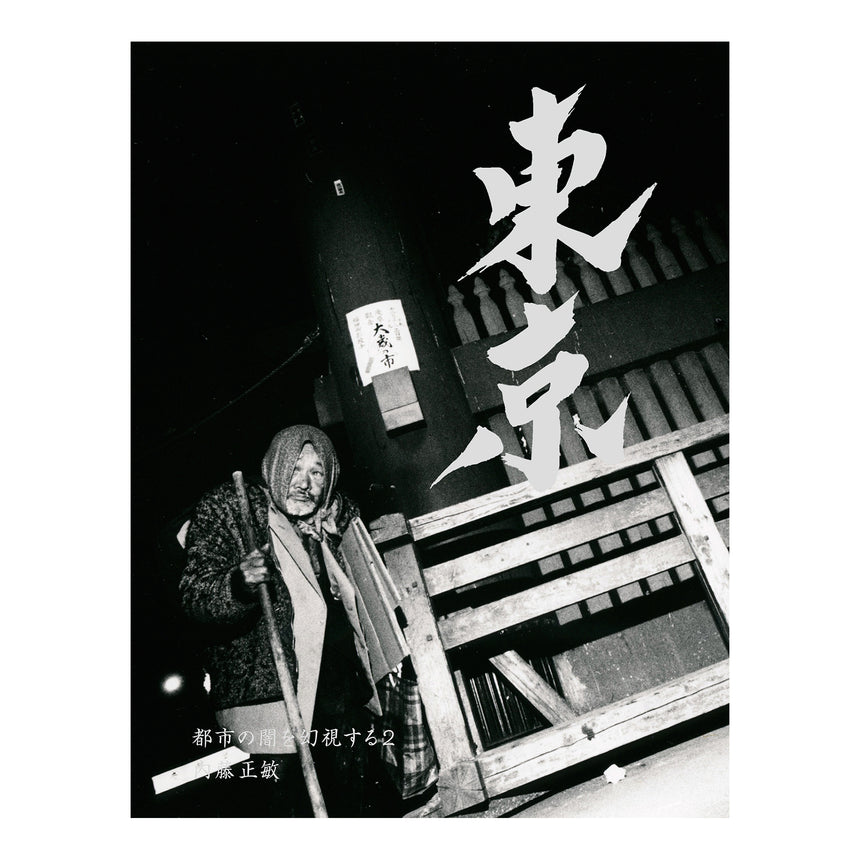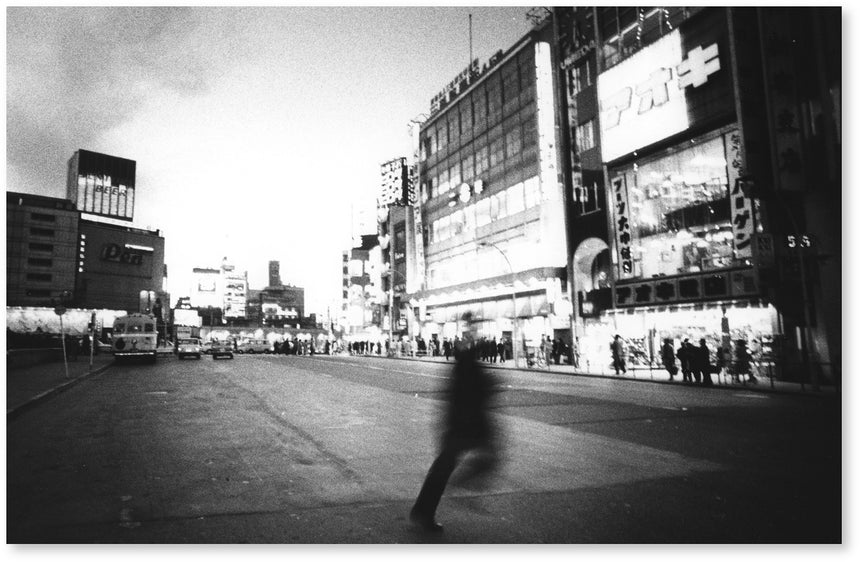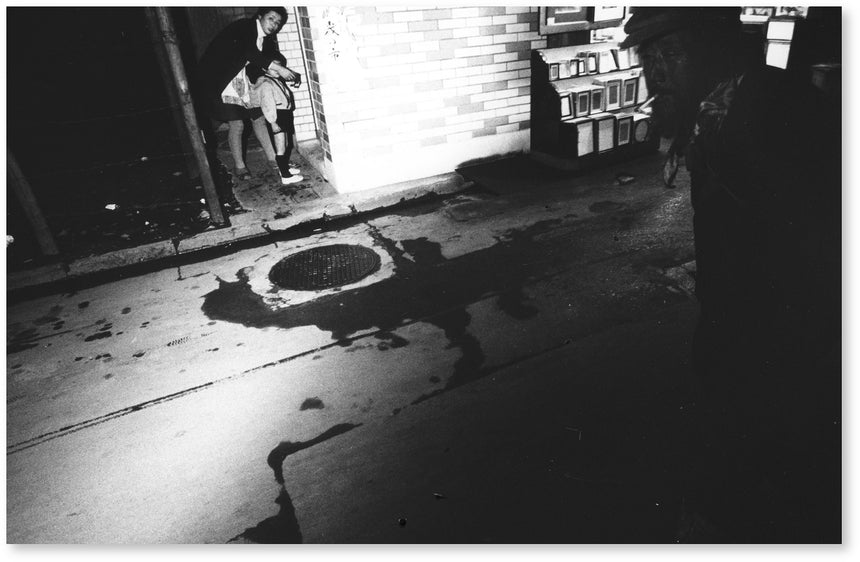東京 都市の闇を幻視する 2
TOKYO: VISION OF ITS OTHER SIDE 2
Masatoshi Naito
(内藤正敏)
¥4,300 JPY
"It was from 1970 to 1985 when I intensively photographed Tokyo. Japan was radically changing as rapid economical growth was underway. Old houses and buildings were being destroyed and replaced by new ones including modern skyscrapers. Even today, Tokyo is still expanding.
I thought it would be quite interesting if I shot Tokyo using the technique of time-lapse photography. I fixed a full-automatic camera on the top of the Tokyo Tower, turning it to various directions such as Shinjuku and Ginza and releasing the shutter once every hour every day for ten years. Back then, filming cameras could shoot 24 frames a second. There are 24 hours in a day so I could shoot a one-second short movie with 24 frames every day. Therefore the movie would add up to 30 seconds in a month and about one hour in ten years. It would depict the rapid development of Tokyo in super-slow speed, revealing the real essence of Tokyo as an ever-moving huge life form like a protozoan–––I expected so.
The image of Tokyo as a "huge life form" did not come from literary imagination. It was based on what I sensed physically during my walking around Tokyo in those days.
In Tokyo, there are layers of sediment from diverse times. Tokyo today. Tokyo in the time of the post-war black-markets. Tokyo in the Edo period. A day of the people in Tokyo commonly begins with getting up in the morning and going to work. When the day's work is done, they go home after stopping by shopping streets or drinking bars.
Nowadays, I see crowds of people flooding all over the Tokyo city area from morning to night. The crowds are always there, from the first train to the last train of the Yamanote Line, the Chuo Line, subways and various private railways. However, when the last trains are gone, along with the businessmen and women, students, and the workers of restaurants and bars, Tokyo is deserted, and the "other face of Tokyo" emerges.
Somebody gathers food dumped by bars and restaurants. Another one picks up cardboard boxes and cans that may sell. There are people sleeping on the street. Some of them are drinking alcohol. Homeless people begin to act lively. Exactly, Tokyo as a "huge life form" reveals itself."
w21.6 x h28 cm
44 Pages
25 Images(b/w)
Softcover (hand-sewn), double gatefold cover.
Doubletone Offset
Limited edition of 1000
Published in 2016
ISBN 978-4-905052-95-1
「私が東京を集中的に写し歩いたのは、1970年から85年。日本が高度経済成長で急激に変貌した時期だった。古い家屋やビルが壊され、次々と近代的な高層ビルが建てられていった。現在も東京は膨張しつづけている。
もし「東京」を緩速度撮影で写したら面白い映画になるに違いないと思った。
東京タワーのテッペンに全自動のカメラをすえつけ、新宿や銀座などにレンズを向け、毎日、一時間に1枚シャッターを切り、10年間写しつづける。当時の映画カメラは、長尺フィルムで1秒間に24コマ写す撮影機だった。つまり1日は24時間だから、一日に24コマ、つまり一秒の映画が撮れる。単純計算すれば一ヶ月で30秒、10年間でほぼ1時間の映画が写せることになる。新しいビルが次々と建てられ、急速に変貌する東京の姿が超スローモーション撮影特有の効果で、まるで原生動物のように蠢めく「巨大な生命体」としての東京の本質が、リアルに写し出されるのではないか-----、そう思ったのである。
「巨大な生命体」という「東京」のイメージは単に文学的な想像で思いついたものではない。実際に東京を歩きまわって肌で感じた身体感覚からである。
東京には多様な時間が沈殿している。現在の東京。戦後ヤミ市時代の東京。江戸時代の東京-----。東京に住む人々の一般的な生活は朝起きてから会社に行って働く。仕事が終わってから、盛り場に寄って買い物をしたりバーで酒を飲んだりして家に帰る。
現在、東京で目にするのは、朝から夜までの人間の群れ。JR山手線や中央線、地下鉄や近郊私鉄の始発から終電までの時間の群衆である。ところが最終電車が出て、サラリーマンやOLや主婦や学生たちが帰り、バーや酒場で働いていた人たちも帰って、無人になった東京に「もう一つの東京」が出現する。
酒場や食堂から捨てられた残飯を漁って歩く人。ダンボールや空き缶などの売れるゴミを拾って集め歩く人。路上で寝込む人。なかには酒を飲んでいる人もいる。ホームレスの人たちが生き生きと蠢めきだす。まさに「巨大な生命体」としての東京が出現するのである。」
w21.6 x h28 cm
44 ページ
25 イメージ(白黒)
並製本(手綴じ) 表紙は両観音仕様
白黒オフセット印刷
限定1000部
Published in 2016
ISBN 978-4-905052-95-1
I thought it would be quite interesting if I shot Tokyo using the technique of time-lapse photography. I fixed a full-automatic camera on the top of the Tokyo Tower, turning it to various directions such as Shinjuku and Ginza and releasing the shutter once every hour every day for ten years. Back then, filming cameras could shoot 24 frames a second. There are 24 hours in a day so I could shoot a one-second short movie with 24 frames every day. Therefore the movie would add up to 30 seconds in a month and about one hour in ten years. It would depict the rapid development of Tokyo in super-slow speed, revealing the real essence of Tokyo as an ever-moving huge life form like a protozoan–––I expected so.
The image of Tokyo as a "huge life form" did not come from literary imagination. It was based on what I sensed physically during my walking around Tokyo in those days.
In Tokyo, there are layers of sediment from diverse times. Tokyo today. Tokyo in the time of the post-war black-markets. Tokyo in the Edo period. A day of the people in Tokyo commonly begins with getting up in the morning and going to work. When the day's work is done, they go home after stopping by shopping streets or drinking bars.
Nowadays, I see crowds of people flooding all over the Tokyo city area from morning to night. The crowds are always there, from the first train to the last train of the Yamanote Line, the Chuo Line, subways and various private railways. However, when the last trains are gone, along with the businessmen and women, students, and the workers of restaurants and bars, Tokyo is deserted, and the "other face of Tokyo" emerges.
Somebody gathers food dumped by bars and restaurants. Another one picks up cardboard boxes and cans that may sell. There are people sleeping on the street. Some of them are drinking alcohol. Homeless people begin to act lively. Exactly, Tokyo as a "huge life form" reveals itself."
w21.6 x h28 cm
44 Pages
25 Images(b/w)
Softcover (hand-sewn), double gatefold cover.
Doubletone Offset
Limited edition of 1000
Published in 2016
ISBN 978-4-905052-95-1
「私が東京を集中的に写し歩いたのは、1970年から85年。日本が高度経済成長で急激に変貌した時期だった。古い家屋やビルが壊され、次々と近代的な高層ビルが建てられていった。現在も東京は膨張しつづけている。
もし「東京」を緩速度撮影で写したら面白い映画になるに違いないと思った。
東京タワーのテッペンに全自動のカメラをすえつけ、新宿や銀座などにレンズを向け、毎日、一時間に1枚シャッターを切り、10年間写しつづける。当時の映画カメラは、長尺フィルムで1秒間に24コマ写す撮影機だった。つまり1日は24時間だから、一日に24コマ、つまり一秒の映画が撮れる。単純計算すれば一ヶ月で30秒、10年間でほぼ1時間の映画が写せることになる。新しいビルが次々と建てられ、急速に変貌する東京の姿が超スローモーション撮影特有の効果で、まるで原生動物のように蠢めく「巨大な生命体」としての東京の本質が、リアルに写し出されるのではないか-----、そう思ったのである。
「巨大な生命体」という「東京」のイメージは単に文学的な想像で思いついたものではない。実際に東京を歩きまわって肌で感じた身体感覚からである。
東京には多様な時間が沈殿している。現在の東京。戦後ヤミ市時代の東京。江戸時代の東京-----。東京に住む人々の一般的な生活は朝起きてから会社に行って働く。仕事が終わってから、盛り場に寄って買い物をしたりバーで酒を飲んだりして家に帰る。
現在、東京で目にするのは、朝から夜までの人間の群れ。JR山手線や中央線、地下鉄や近郊私鉄の始発から終電までの時間の群衆である。ところが最終電車が出て、サラリーマンやOLや主婦や学生たちが帰り、バーや酒場で働いていた人たちも帰って、無人になった東京に「もう一つの東京」が出現する。
酒場や食堂から捨てられた残飯を漁って歩く人。ダンボールや空き缶などの売れるゴミを拾って集め歩く人。路上で寝込む人。なかには酒を飲んでいる人もいる。ホームレスの人たちが生き生きと蠢めきだす。まさに「巨大な生命体」としての東京が出現するのである。」
w21.6 x h28 cm
44 ページ
25 イメージ(白黒)
並製本(手綴じ) 表紙は両観音仕様
白黒オフセット印刷
限定1000部
Published in 2016
ISBN 978-4-905052-95-1





















